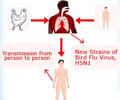Researchers from the Icahn School of Medicine at Mount Sinai say that a new strategy that dismantles a viral genome in human lung cells will ensure safe research on deadly strains of influenza.

The strategy they developed and tested will enable healthy molecules in human lung cells to latch on to these viruses and cut the bugs up before they have a chance to infect the human host.
Findings from the study, led by Benjamin tenOever and Adolfo Garcia-Sastre, both Fishberg Professors in the Department of Medicine and Department of Microbiology at Mount Sinai, should resolve concerns that led in 2012 to a worldwide, yearlong voluntary moratorium on research into the deadly H5N1 bird flu.
The ban came after several scientific teams successfully altered the H5N1 viral genome to enable airborne transmission of the bird flu between ferrets — mammals considered a good research model for humans. The public health concern was that altered H5N1 could escape the lab, infect and spread among humans, producing a global pandemic.
"The question last year was whether the risk of altered bird flu escaping laboratories justified the science aimed at understanding the transmission of these viruses. With our method, the possibility of human transmission is no longer a concern," says Dr. tenOever.
H5N1 normally spreads between poultry and wild birds. It can be transmitted from birds to humans, with difficulty, and has only rarely been passed between people. It is lethal to humans. Since 2003, it has killed 360 people out of 610 people infected.
Advertisement
Dr. tenOever is known internationally for his work on using microRNAs (miRNAs) — small noncoding RNA molecules that help regulate gene expression — to help the body fight off viral pathogens. He has created a strategy that mimics the system plants use to destroy invading viruses.
Advertisement
In this study, the scientists discovered a specific miRNA (miR-192) that is found in human and mouse lung cells, but not in the lungs of ferrets. They added multiple binding sites for miR-192 on to the H5N1 genome, and demonstrated in mice that, upon contact, lung cells destroyed the virus. They then demonstrated that H5N1 transmission between ferrets was not decreased when altered virus was used. The researchers also showed the approach works with other influenza A viruses.
"It is clear that we can apply this technology to any virus," Dr. tenOever says. "The only requirements are that we need a miRNA that is present in humans, but not in the model system where we want to study the virus, such as in ferrets. We also need a viral genome that permits insertion of miRNA target sites."
And once a virus is altered to contain the miRNA target sites, it can replicate ad infinitum for research in laboratories worldwide, Dr. tenOever says. "There is no need to continually go back to the drawing board," he says.
In January, a handful of scientists in nine nations resumed their research on H5N1, using standard biocontainment procedures. Drs. tenOever and Garcia-Sastre believe that adding this molecular biocontainment strategy to their research should relieve any public concern pertaining to this research.
Source-Eurekalert









